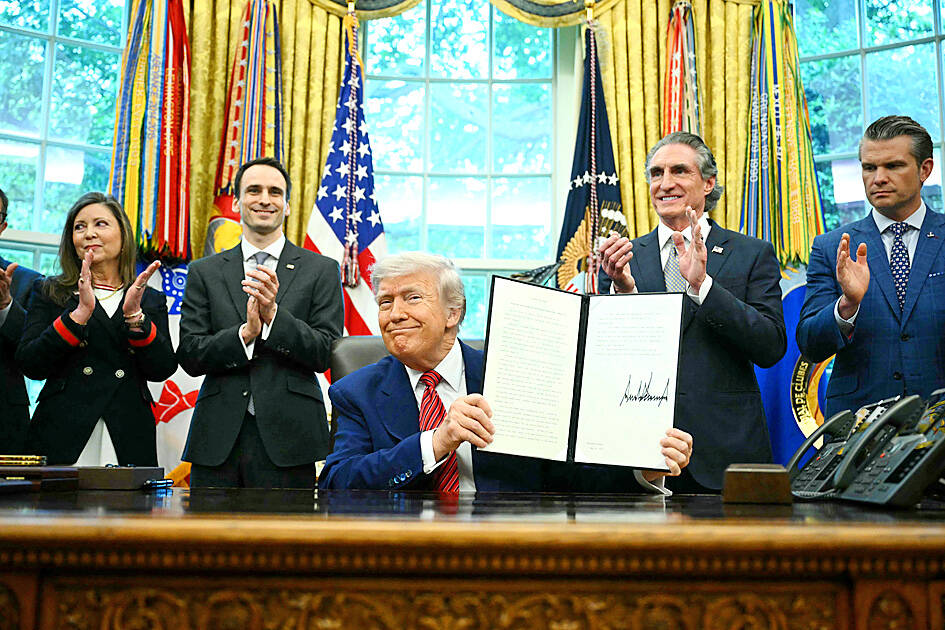Investors were growing optimistic that US President Donald Trump’s trade wars had started to calm down. His latest tariff broadsides quickly disabused them of that notion.
Initial agreements with the UK and China buoyed hopes on Wall Street and in corporate boardrooms that the US president was starting to peel back the highest US tariffs in nearly a century.
However, Friday delivered a harsh reminder of Trump’s volatile policymaking and penchant for brinkmanship, when he threatened a 50 percent tariff on the EU and a 25 percent levy on smartphones if companies including Apple Inc and Samsung Electronics Co failed to move production to the US.

Photo: AFP
Equities fell across the globe, the US dollar slumped to its lowest level since 2023 and business leaders were left to grapple with the notion that Trump-generated uncertainty is here to stay.
“Today’s news that Trump is threatening enormous tariffs on the EU and is singling out Apple as a firm are examples of what we should expect for the next two months if not for the rest of the year,” Peterson Institute for International Economics executive vice president Marcus Noland said. “Peace has not broken out.”
A White House official said that the US president was hoping to sign more trade agreements with some major economies and then fast-track deals with others during a 90-day pause on his tariffs announced on April 2.
Some arrangements are said to be close, including one with India, US Secretary of the Treasury Scott Bessent told Fox News on Friday.
Business leaders and consumers would be watching carefully for next steps. The US president’s Friday directive on the EU offered a preview of what he said his administration might do with dozens of trading partners seeking lower duties: Simply dictate tariff levels.
Trump ally Steve Bannon said the president’s reaction was in part due to what he saw as a lack of progress on trade issues last week at a G7 finance ministers meeting, particularly given the relatively quick deal he was able to strike with the UK.
Other countries without deals in progress should be worried, Bannon said, calling it a “storm warning.”
Trump seemed as committed to tariffs as ever. He threw his support behind a partnership between US Steel Corp and Japan’s Nippon Steel Corp, crediting his tariffs for finalizing the pact that had been in the works for years. That announcement came as Japanese trade negotiators were holding talks with US trade officials in Washington.
When Trump paused his higher April 2 tariffs, he left in place a 10 percent charge on most trading partners. Separate levies on steel, aluminum and autos remain. Trump has also promised a range of new import taxes on copper, semiconductor chips, pharmaceutical drugs, lumber and aircraft parts — all of which could drive up the total effective tariff rate.
At the same time, Trump showed a willingness to negotiate on duties imposed on specific sectors when the US and UK agreed to negotiate new rates on metals.
Tariff levels remain uncertain, but “will probably remain elevated for the foreseeable future,” Goldman Sachs Group Inc analysts wrote in a note on May 14.
The bank forecast that the effective US tariff rate would rise by 13 percentage points this year, to the highest level since the 1930s.
It could all be for naught, with Goldman saying “higher bilateral tariffs are unlikely to drive a substantial increase in domestic production,” a stated goal of Trump.
Talks are advancing with other partners including India, Japan, Vietnam and Israel. Some short-term relief could be possible, but the threat of fresh trade feuds is widespread across several countries.
Trump’s penchant for out-of-nowhere threats, even on countries with which the US has trade agreements, sows doubt in the longevity of any deal he strikes, Noland said.
“It’s really quite extraordinary that we had free-trade agreements with some of these countries — South Korea, Australia — and they’re just getting hit with tariffs,” Noland said. “His willingness to tear up previous agreements and ignore them has to be highly concerning for other countries.”

With an approval rating of just two percent, Peruvian President Dina Boluarte might be the world’s most unpopular leader, according to pollsters. Protests greeted her rise to power 29 months ago, and have marked her entire term — joined by assorted scandals, investigations, controversies and a surge in gang violence. The 63-year-old is the target of a dozen probes, including for her alleged failure to declare gifts of luxury jewels and watches, a scandal inevitably dubbed “Rolexgate.” She is also under the microscope for a two-week undeclared absence for nose surgery — which she insists was medical, not cosmetic — and is

GROWING CONCERN: Some senior Trump administration officials opposed the UAE expansion over fears that another TSMC project could jeopardize its US investment Taiwan Semiconductor Manufacturing Co (TSMC, 台積電) is evaluating building an advanced production facility in the United Arab Emirates (UAE) and has discussed the possibility with officials in US President Donald Trump’s administration, people familiar with the matter said, in a potentially major bet on the Middle East that would only come to fruition with Washington’s approval. The company has had multiple meetings in the past few months with US Special Envoy to the Middle East Steve Witkoff and officials from MGX, an influential investment vehicle overseen by the UAE president’s brother, the people said. The conversations are a continuation of talks that

CAUTIOUS RECOVERY: While the manufacturing sector returned to growth amid the US-China trade truce, firms remain wary as uncertainty clouds the outlook, the CIER said The local manufacturing sector returned to expansion last month, as the official purchasing managers’ index (PMI) rose 2.1 points to 51.0, driven by a temporary easing in US-China trade tensions, the Chung-Hua Institution for Economic Research (CIER, 中華經濟研究院) said yesterday. The PMI gauges the health of the manufacturing industry, with readings above 50 indicating expansion and those below 50 signaling contraction. “Firms are not as pessimistic as they were in April, but they remain far from optimistic,” CIER president Lien Hsien-ming (連賢明) said at a news conference. The full impact of US tariff decisions is unlikely to become clear until later this month

Nintendo Co hopes to match the runaway success of the Switch when its leveled-up new console hits shelves on Thursday, with strong early sales expected despite the gadget’s high price. Featuring a bigger screen and more processing power, the Switch 2 is an upgrade to its predecessor, which has sold 152 million units since launching in 2017 — making it the third-best-selling video game console of all time. However, despite buzz among fans and robust demand for pre-orders, headwinds for Nintendo include uncertainty over US trade tariffs and whether enough people are willing to shell out. The Switch 2 “is priced relatively high”